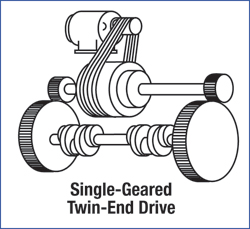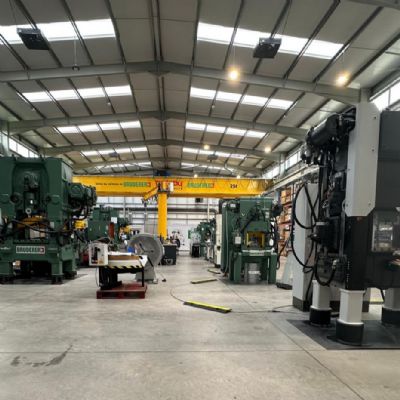Managing Press Loads, Part 2: Press Selection
February 1, 2011Comments
Maintaining an even distribution of the work load across the slide face (ram) helps ensure good part quality, improves die life and reduces press maintenance. As discussed last month, when the working forces in a die are not distributed evenly, the slide
can tip and move laterally in the direction of the greatest force. If this movement occurs with the punches engaged with other die components, excessive wear or damage can occur.
Fig. 1
An important first step in managing die-tipping moments: evaluating the strip layout and the timing of progressive-die stations. The position of the various die stations as the die closes will alert the stamper to any tipping moment present. Good progressive-die engineering practices include a complete evaluation and balancing of loads generated at each die station. However, even the best practices can be defeated when die tipping is caused by improper press selection.
Setting a die in a straightside press with a single slide connection requires that the load be carefully centered under the slide connection. Although a centered load is als good practice, it is particularly important in this type of press. Visualize the slide in a single-connection press acting as a seesaw, with the slide connection acting as the fulcrum. A centered stamping load prevents slide tipping, but a slight unbalance in the loading condition will tip the slide, transferring some of the working pressure to the press gibbing rather than to the press bed.
Fortunately, straightside presses having two connection points are very common. Selecting a press with a two-point connection significantly reduces the seesaw effect when the loads are not centered. However, this does not mean setting a die in a machine with a two-point connection is a cure-all for poor die engineering and excessive slide tipping.
Wide-spaced slide connections also will combat the negative effects of off-center loading. By placing the connection points toward the outside of the slide, the increased distance between the connection
 |
| Fig. 2 |
Another press feature to look for: a lube-free preloaded roller slide guide. These zero-clearance systems help minimize the affects of slide-tipping conditions. Zero clearance improves slide guiding while the system’s preloaded characteristic provides immediate resistance to any lateral slide movement caused by off-center loads, keeping it parallel throughout the press stroke.
As a rule, the potential for misalignment due to ram tipping should be managed or eliminated via die design. Although it is not practical to design and build dies with perfectly centered loading, it also is not wise to allow the press system to compensate for extreme off-center loading conditions. When excessive tipping moments are present, it is best to redistribute and balance the cutting and forming loads as evenly as possible, usually by revising the die design; offsetting the placement of the die in the press; or by providing offsetting forces or “dummy loads,” such as coining an area of the stamping that ends up as trim scrap in later die operations. MF
View Glossary of Metalforming Terms
Technologies: Stamping Presses, Tooling








